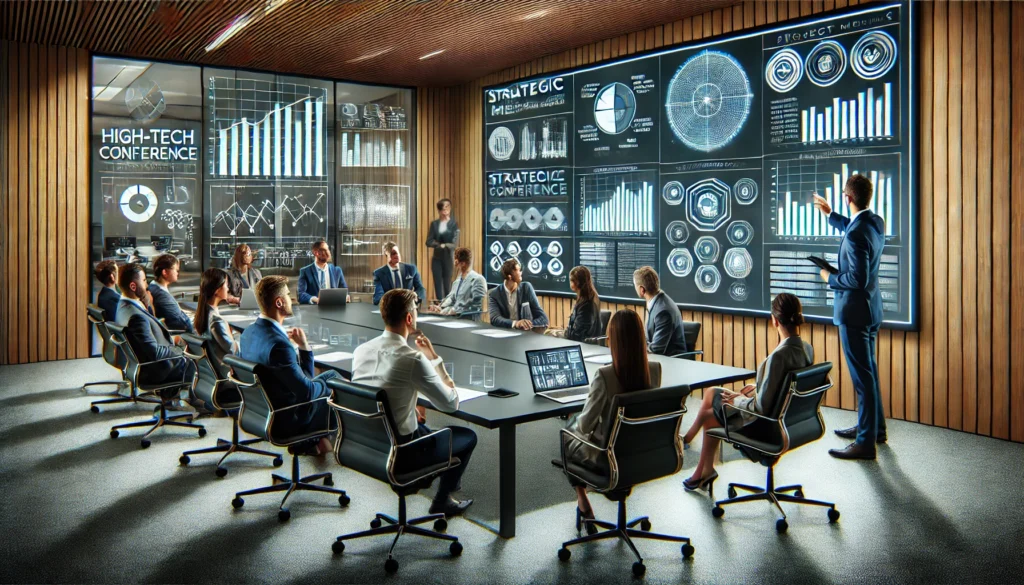In the ever-evolving landscape of business and professional environments, team meetings serve as a cornerstone for collaboration, decision-making, and innovation. However, the effectiveness of these meetings hinges significantly on how well they are structured. A well-crafted agenda can transform a mundane meeting into a productive and engaging session. This article delves into strategies for streamlining team meeting agendas, offering insights and practical advice to optimize your meetings for maximum impact.
You may also like: How to Keep Meetings Focused and Efficient
Understanding the Importance of Meeting Agendas
A meeting agenda isn’t just a list of topics to be covered; it’s a strategic tool that outlines the structure and flow of a meeting. It sets the tone, dictates the pace, and ensures that all necessary points are addressed. By defining clear objectives and expectations, an effective agenda reduces wasted time and enhances the overall productivity of team meetings.
Setting the Tone with Agendas
The agenda serves as the initial communication that sets the expectations for the meeting. By clearly outlining the meeting’s purpose, participants know what to prepare and what is expected of them. This preemptive clarity can prevent misunderstandings and ensure everyone is on the same page from the start. A well-communicated agenda can also motivate participants to bring their best to the table, fostering a culture of preparedness and respect.
Dictating the Pace
Each agenda item should have a designated time frame to maintain a steady and productive pace throughout the meeting. This prevents discussions from drifting and ensures that time is allocated according to the importance of each topic. Time management is crucial in maintaining participant engagement and ensuring that meetings conclude on schedule, thereby respecting everyone’s time.
Ensuring Comprehensive Coverage
An agenda acts as a checklist to guarantee that no critical topics are overlooked during the meeting. It provides a framework that guides discussions, helping participants stay focused and on topic. By ensuring all necessary points are addressed, the meeting can achieve its objectives efficiently, reducing the need for follow-up meetings or additional clarifications.
The Core Components of a Successful Agenda
A well-structured agenda typically includes several key components: objectives, topics for discussion, time allocations, and designated speakers. Each of these elements plays a crucial role in guiding the meeting and keeping participants focused on the task at hand.
Defining Clear Objectives
Objectives are the backbone of any meeting agenda. Clearly define what the meeting aims to achieve. Are you brainstorming new ideas, solving problems, or making decisions? By setting explicit goals, participants understand the meeting’s purpose and can prepare accordingly. Objectives not only guide the preparation but also provide a benchmark for assessing the meeting’s success.
Curating Relevant Discussion Topics
Discussion topics should directly align with the meeting’s objectives, ensuring relevance and focus. Prioritize these topics based on their importance and the impact they have on the meeting’s goals. This prioritization helps in managing time effectively and ensures that the most critical issues are addressed first.
Allocating Time Effectively
Assign specific time slots for each agenda item to prevent discussions from veering off track. This helps maintain a steady pace and ensures that all topics are addressed within the allocated time. Time allocations should be realistic, allowing for thorough discussion without rushing, yet ensuring the meeting is efficient and timely.
Designating Speakers and Roles
Identify who will lead each discussion or present information. This clarifies roles and responsibilities, fostering a more organized and efficient meeting. Designated speakers should be well-prepared to provide insights and facilitate discussions, ensuring that the meeting flows smoothly and productively.
Crafting Effective Team Meeting Agendas
To create a meeting agenda that truly enhances productivity, consider the following tips:
1. Start with a Clear Purpose
Before crafting your agenda, define the meeting’s primary purpose. What do you hope to accomplish? This clarity will guide the selection of agenda items and set the stage for a focused discussion. A clear purpose serves as a compass, directing the meeting towards achieving its set objectives.
2. Prioritize Agenda Items
Identify the most critical topics and place them at the top of your agenda. By addressing high-priority items first, you ensure that essential issues receive the attention they deserve, even if time is limited. Prioritization helps in maintaining focus and ensures that the meeting’s energy is directed towards the most impactful discussions.
3. Be Realistic with Time
Allocate sufficient time for each agenda item while being mindful of the total meeting duration. Overloading the agenda with too many topics can lead to rushed discussions and unresolved issues. Being realistic with time ensures that discussions are thorough, yet concise, allowing for meaningful dialogue without unnecessary prolongation.
4. Encourage Participant Input
Invite team members to contribute to the agenda by suggesting topics or sharing insights related to the meeting’s objectives. This collaborative approach fosters engagement and ensures that diverse perspectives are considered. Participant input can enrich the meeting’s content, making it more comprehensive and inclusive.

5. Review and Revise
Before finalizing the agenda, review it to ensure it aligns with the meeting’s objectives and is feasible within the time constraints. Revise if necessary, to ensure clarity and focus. A well-reviewed agenda is more likely to result in a successful meeting outcome, as it reflects thoughtful planning and consideration.
Monthly and Department Meeting Agendas
Different types of meetings require tailored agendas. Here’s how to structure agendas for monthly and department meetings:
Monthly Team Meetings
Monthly meetings often focus on progress updates, goal setting, and strategic planning. Key agenda items might include:
Reviewing Achievements and Challenges
Begin by evaluating the progress made in the previous month. Discuss achievements to celebrate and challenges to address, setting a constructive tone for the meeting. This review provides a foundation for learning and improvement, fostering a culture of continuous development.
Discussing Upcoming Projects
Outline upcoming projects or initiatives, detailing their objectives and expected outcomes. This forward-looking approach helps in aligning the team with future goals and preparing them for upcoming tasks. It also ensures that everyone is on the same page regarding the project timelines and responsibilities.
Evaluating Goals and Performance
Assess the team’s performance against set goals, identifying areas for improvement. This evaluation is critical for understanding progress and making necessary adjustments to strategies and objectives. It also encourages accountability and transparency within the team.
Open Floor for Feedback
Allow team members to share feedback and suggestions, promoting an open and collaborative environment. This segment encourages active participation and ensures that diverse viewpoints are considered in decision-making. Feedback can lead to innovative solutions and improvements in team dynamics.
Department Meetings
Department meetings are typically more specialized and focus on specific areas of responsibility. Consider including:
Updates on Departmental Projects
Provide updates on ongoing projects, highlighting key developments and achievements. This ensures that all department members are informed and aligned with the current status and future direction of projects. It also facilitates the sharing of best practices and lessons learned.
Addressing Challenges
Identify and discuss department-specific challenges or concerns, exploring potential solutions. This targeted focus allows for in-depth analysis and problem-solving, enhancing the department’s efficiency and effectiveness. It also fosters a proactive approach to overcoming obstacles.
Promoting Cross-Departmental Collaboration
Highlight opportunities for collaboration with other departments, encouraging synergy and innovation. Cross-departmental collaboration can lead to creative solutions and improved resource utilization, benefiting the organization as a whole. It also strengthens inter-departmental relationships and communication.
Incorporating Training Sessions
Include training or development sessions relevant to the department’s needs. Continuous learning and skill enhancement are vital for keeping the team competitive and adaptable. Training sessions can also boost morale and motivation, showing a commitment to employee growth and development.
Running Effective Meetings: Tips and Templates
To maximize the impact of your meetings, consider the following strategies:
1. Use a Template
A meeting agenda template can streamline the planning process and ensure consistency across meetings. Templates provide a structured format that can be customized to suit different types of meetings. This consistency ensures that all necessary components are included, making meetings more efficient and organized.

2. Set Ground Rules
Establishing ground rules for meetings helps maintain order and focus. Consider rules such as no interruptions, active participation, and adherence to time limits. Ground rules create a respectful and productive meeting environment, ensuring that discussions are orderly and inclusive.
3. Follow-Up Actions
Conclude each meeting by summarizing key takeaways and assigning follow-up actions. This ensures accountability and keeps the momentum going after the meeting ends. Follow-up actions should be clear and actionable, with assigned responsibilities and deadlines to ensure progress.
4. Evaluate Meeting Effectiveness
Regularly evaluate the effectiveness of your meetings to identify areas for improvement. Solicit feedback from participants and analyze whether the meeting achieved its objectives. This evaluation helps in refining meeting processes, ensuring continuous improvement and greater impact.
5. Leverage Visual Aids
Incorporate visual aids such as charts, graphs, or slides to enhance understanding and engagement. Visuals can make complex information more accessible and engaging, facilitating better comprehension and retention. They also add variety to the meeting format, keeping participants interested.
The Future of Meeting Agendas
As businesses continue to embrace digital tools and remote work, the nature of meetings is evolving. Virtual meetings, for instance, require new approaches to agenda-setting, such as accommodating different time zones and utilizing collaboration platforms.
Leveraging Technology
Digital tools offer innovative ways to enhance meeting agendas. Consider using project management software, shared documents, and video conferencing platforms to facilitate communication and collaboration. These tools can streamline the agenda-setting process and enhance meeting efficiency by providing real-time updates and seamless communication.
Embracing Flexibility
In a fast-paced world, flexibility is key. Be prepared to adapt your agenda in response to changing circumstances or new developments. This agility ensures that meetings remain relevant and productive, accommodating the dynamic nature of modern business environments.
Incorporating Hybrid Meeting Models
As remote work becomes more prevalent, hybrid meeting models that combine in-person and virtual participation are gaining popularity. Agendas for hybrid meetings should consider the needs of both remote and onsite participants, ensuring that everyone is equally engaged and informed. This inclusivity promotes a cohesive team dynamic, regardless of physical location.

Conclusion
In conclusion, streamlining team meeting agendas is a vital step toward enhancing the efficiency and effectiveness of your meetings. By crafting well-structured agendas, prioritizing key topics, and leveraging technology, you can transform your meetings into powerful tools for collaboration and innovation. Embrace these strategies to optimize your team’s performance and drive success in today’s dynamic business landscape.
With these insights and tips, you’re well-equipped to create impactful meeting agendas that lead to meaningful outcomes. Remember, a well-planned agenda is the foundation of a productive meeting, and its benefits extend far beyond the meeting room. As you continue to refine and adapt your agenda-setting practices, your meetings will become a catalyst for achieving organizational goals and fostering a culture of continuous improvement.
Further Reading:
How to Run Team Meetings That Actually Matter [+Agenda Samples]
How to Write a Team Meeting Agenda: Best Practices & Templates
8 Ideas to Help You Transform Your Team Meeting Agendas
Important Note: The information contained in this article is for general informational purposes only, and should not be construed as health or medical advice, nor is it intended to diagnose, prevent, treat, or cure any disease or health condition. Before embarking on any diet, fitness regimen, or program of nutritional supplementation, it is advisable to consult your healthcare professional in order to determine its safety and probable efficacy in terms of your individual state of health.
Regarding Nutritional Supplements Or Other Non-Prescription Health Products: If any nutritional supplements or other non-prescription health products are mentioned in the foregoing article, any claims or statements made about them have not been evaluated by the U.S. Food and Drug Administration, and such nutritional supplements or other health products are not intended to diagnose, treat, cure, or prevent any disease.


